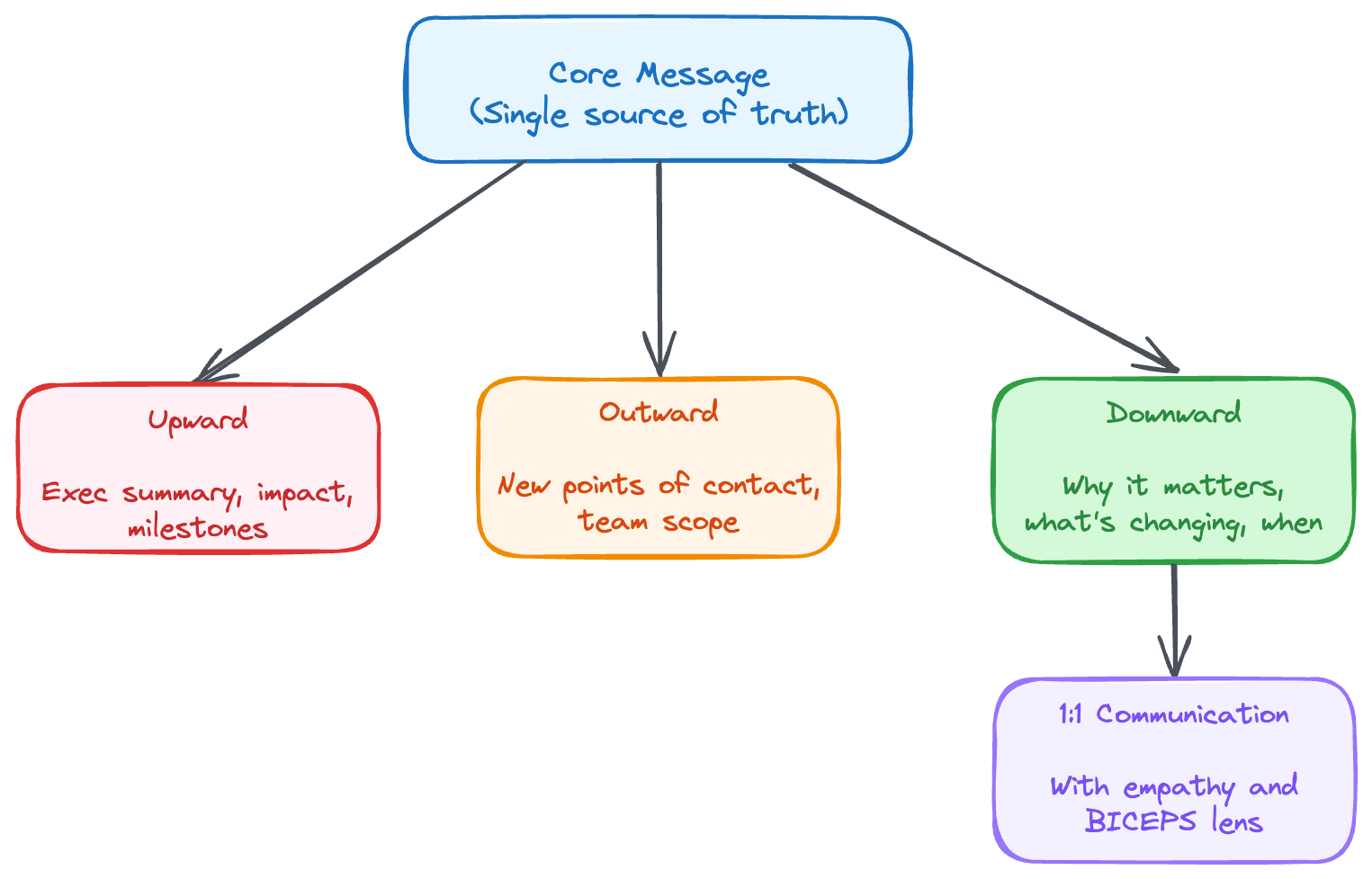A Lightweight Communication Plan for Meaningful Change
One of the most effective things you can do during a change is to minimize surprise and maximize understanding. Today I want to share a simple technique that helps me do exactly that: a lightweight communication plan that keeps messages consistent while tailoring them to different audiences.
The key is to draft your core message up front as you plan the change. This allows you to craft communication that is tailored to multiple audiences while staying grounded in the same core story about drivers, outcomes, and impact.
Plans rarely go exactly as expected. But with a bit of upfront communication planning, you can avoid a lot of the chaos and keep people moving forward with clarity and trust.
Start with the Story You’ll Tell Everyone
One of the biggest advantages of building a structured core message is that it allows you to tailor your communication to each audience without losing alignment. You can speak directly to what’s relevant for each group—your leadership chain, peers, the team—while still telling one coherent story.
Instead of rewriting or improvising each time, you start from a shared foundation. That means fewer contradictions, less confusion, and much stronger trust. It also means you can define most of your messaging in a single sitting. That’s not just an efficient use of your time. Defining your core message all at once, with focus, gives you the confidence that you’ve drafted a complete message.
Here’s how a single core message flows into tailored communication for each audience:

A Simple Structure to Get It All Down
The framework itself is straightforward and consists of a few sections:
- what is changing
- why is it changing
- when is it changing
- who is affected by the change
- key activities related to the change
Every section contributes to a strong message, but spend the most time on the “why.” This is where you explain what’s driving the decision and what outcomes you’re aiming for. It’s the foundation of shared understanding, so don’t rush it.
This structure helps you focus on the core. Keep your notes brief, direct, and bullet-based—you’ll shape them into audience-specific messages later.
All of this can live in a single doc and can be drafted surprisingly quickly. That document becomes your source of truth for every version of the message you deliver. If you want to try this for yourself, I have a template you can use for your next change:
A Real-World Example
Early in a new role, I inherited two engineering teams. One was focused on sustaining work and staffed mostly with junior engineers. The other built core features and included our most senior folks. But the lines between their work weren’t as clean as their names suggested. The sustaining team often tackled core development tasks, and the core team routinely handled support and maintenance.
This overlap meant junior engineers were tackling complex work without access to mentorship. It also led to underutilization on both sides and a lot of duplicated planning. So I merged the teams under one manager, creating a single, seven-person group with a broader roadmap and better balance.
I used the framework to define what was changing, why it mattered, who it affected, and what needed to happen operationally—like combining Jira boards and cleaning up GitHub permissions. Once that core message was locked, I crafted tailored communications:
- To leadership, I emphasized planning efficiency and improved delivery.
- To partner teams, I clarified ownership boundaries and new points of contact.
- To the engineers, I focused on growth, mentorship, and predictability.
Everyone heard a version that fit their context, but the story stayed consistent. The transition went smoothly, even for those who changed managers. Because we were all clear on the goals, we were able to align and achieve them. I credit a lot of that success to the upfront work of communication planning.
Tailoring the Message Without Losing the Plot
Your core message gives you the flexibility to speak in different ways without scrambling for words. Leaders want clarity on scope and intent. Peers need to know what’s changing for them. The team needs empathy, context, and a space to ask questions.
While planning for group communication is important, don’t forget individuals. Some people may require one-on-one communication if they are particularly impacted or sensitive to this type of change. Keeping track of core needs helps tailor your message to the individual. I particularly like Paloma Medina’s BICEPS framework. When you know what someone values most, you can address the change in a way that resonates and can help them integrate the change successfully.
The Payoff: Alignment, Speed, and Trust
This approach works because it creates clarity before you speak. Writing the core message first helps you clarify your own thinking and get aligned with other leaders. That alignment matters—it prevents conflicting explanations that chip away at trust.
It also saves time. Once the core message is defined, you can write audience-specific messages quickly. You’re not starting from scratch each time. You’re adjusting tone and emphasis, not facts.
Even more importantly, this method gives everyone a shared reference point. You won’t need to worry that someone missed the right Slack thread or got a different version in a 1:1. Everyone—from your direct reports to your cross-functional peers—can come back to the same source of truth.
With communication locked in, your focus can shift to executing the change itself—without distractions from misalignment, confusion, or one-off questions.
Change is unavoidable. Take time to communicate it well. With a little structure upfront, you can bring clarity, confidence, and consistency to even the messiest transitions.
Photo by Lili Popper on Unsplash